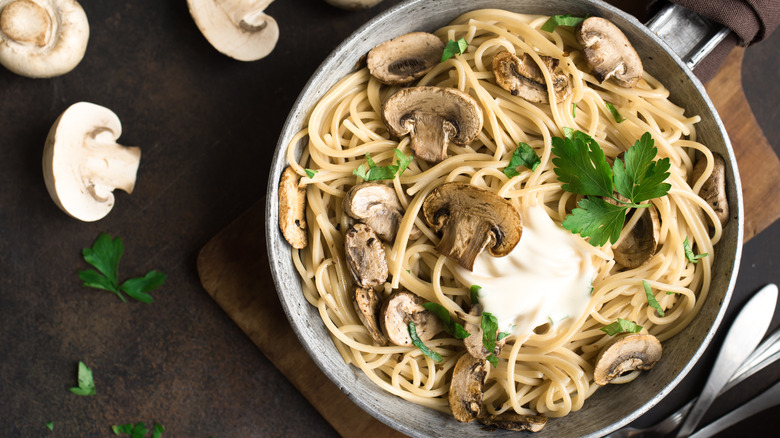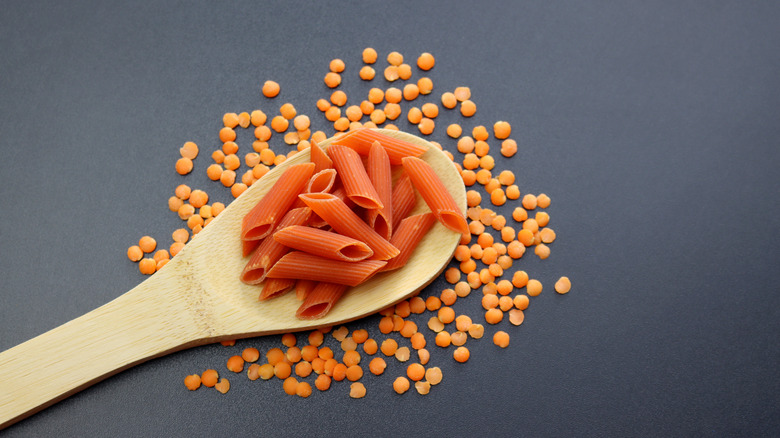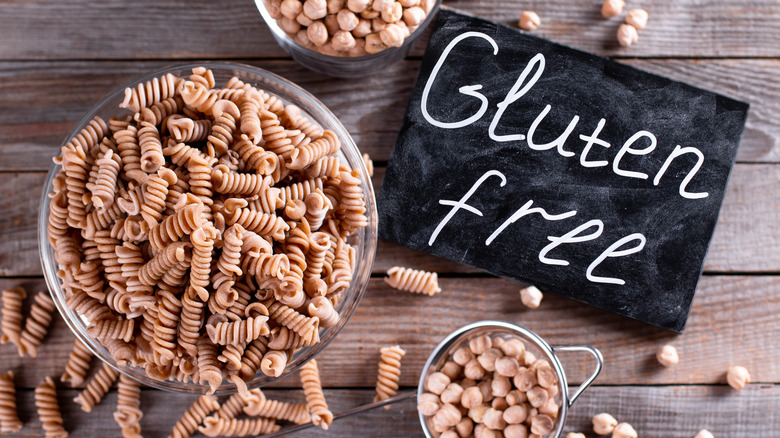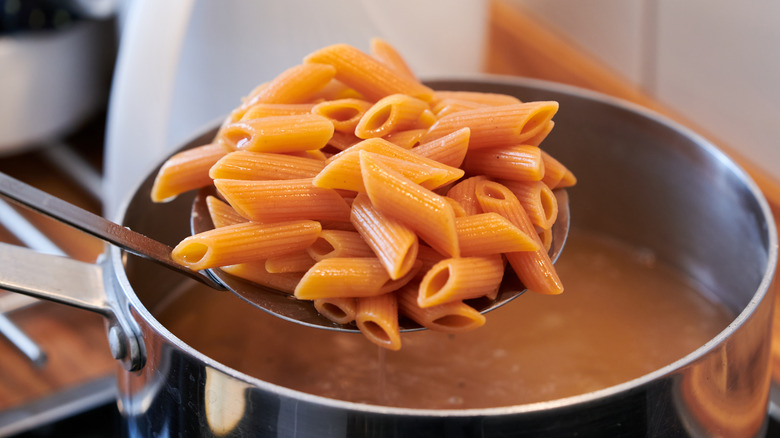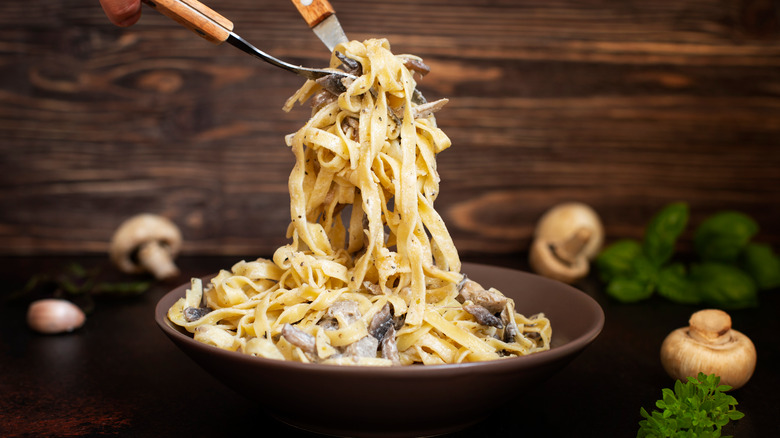Red Lentil Pasta Vs Chickpea Pasta: Which Is More Nutritious?
There are many possible reasons why you would want to swap the good ol' box of semolina or whole wheat pasta sitting in your pantry for lentil or chickpea-based pasta. If you're allergic to gluten or are trying out a new gluten-free diet, semolina and whole wheat pasta are no good. Additionally, gluten-free pasta made from legumes is an excellent way to add more fiber and protein to weekly dinners (via Plant Based). Besides, using lentil or chickpea pasta in place of semolina or whole wheat ones can turn hot, saucy, and parmesan-topped cheesy bowls of pasta into more nutritious meals.
When put against semolina or whole wheat options, lentil and chickpea pasta may be the obvious alternative. However, when it comes to choosing between red lentil pasta and chickpea pasta, things get a bit bewildering. They are both legume-based pasta, so how different could they be? Well, it turns out that there are a few differences between the two to keep in mind the next time you're out pasta shopping.
What is red lentil pasta?
Red lentil pasta is made from, well, red lentils. Regular pasta is usually made by mixing durum wheat flour with eggs and/or water. To make red lentil pasta, you'd swap out durum wheat flour with red lentil flour. You could even make red lentil pasta at home using three ingredients (red lentil flour, eggs, and olives oil) and following three simple steps (via Alpha Foodie).
Due to the natural reddish color of red lentils, red lentil pasta tends to be bright red in color. While most other types of pasta, including semolina, whole wheat, and chickpea pasta, are fairly neutral in terms of flavor, red lentil pasta has a distinctly sweet and nutty flavor of its own (via Plant Based).
Since red lentils tend to lose their shape when cooked, red lentil pasta has a bad rep for getting soggy and mushy. Red lentil pasta contains no gluten and very little starch and so, can overcook easily if you aren't careful. Make sure to keep stirring the pasta to prevent it from sticking together and turning into a big clump. It's also best to make your final pasta dish quickly once the red lentil pasta is cooked to prevent the pasta from sticking together while cooling down. Red lentil pasta may be a bit tricky to cook with as compared to regular pasta however if you do use a few tricks, red lentil pasta can hold a firm shape better than most other legume-based pasta.
What is chickpea pasta?
When it comes to sources of plant-based protein, chickpea ranks pretty high, with about eight grams of protein for half a cup serving of chickpeas (via Good Housekeeping). Plus, if you're looking for the closest legume-based swap to regular white pasta, chickpea pasta is your answer. In fact, The Kitchn claims that if you toss it with lots of sauce and mix it with vegetables, chickpea pasta barely looks or tastes any different from regular pasta.
Chickpea pasta may be the closest match to regular pasta, but when it comes to taste, Plant Based notes that chickpea pasta can taste a tad bitter, though it's nothing some sauce, seasoning, and a generous heap of parmesan shavings can't fix. The website also notes that it takes longer for your body to digest chickpea pasta than it does to digest most other types of pasta, which means that chickpea pasta will keep you full for longer and will help curb snack cravings.
Are there differences in nutrition?
When comparing most legume-based pasta with regular pasta, the former is packed with more nutrition. Plant Based compared the nutritional profiles of Barilla's semolina pasta with Barilla's red lentil rotini and Banza's chickpea penne. The website found that both the red lentil and chickpea pasta have almost double the amount of protein as compared to the semolina pasta for a 56g serving. While Barilla's semolina pasta had only 118g of potassium, Barilla's red lentil pasta had 518g of potassium, and Banza's chickpea one had 510. Potassium can help prevent kidney stones and heart strokes, reduce blood pressure and regulate muscle contractions so it's important to consider potassium-rich pasta alternatives (via Healthline).
Although both red lentil and chickpea pasta are healthier alternatives to regular pasta, red lentil pasta has a slight advantage. Red lentil pasta contains a tad more fiber, is lower in calories, contains almost half the fat that chickpea pasta does, and contains less sodium. While the nutritional profiles of red lentil pasta and chickpea pasta aren't vastly different, if you must choose the healthier one, red lentils are the winner.
Can you swap one for the other?
Plainly speaking, you could swap any pasta with another one. The only thing to stop you is the lack of availability of a certain kind of pasta in your pantry and your imagination. If you are picky about the taste, texture, and look of your pasta, there are certain dishes where one type of pasta can be better than the other.
Red lentil pasta has a nutty flavor of its own, and so it can add a nice and earthy flavor to pasta salads. The Kitchn finds that the flavor of red lentil pasta goes very well in a mildly sweet coconut curry sauce or a veggie mushroom Bolognese. On the flip side, if you like a neutral pasta that will be a great base for lots of additional flavor, chickpea pasta is best (via Plant Based). If you're only using a legume-based pasta for its added nutritional value and would much rather prefer the texture and look of regular pasta, you might want to stick with chickpea pasta, as it tends to be the closest to regular pasta. You can use chickpea pasta in pretty much any recipe that calls for regular pasta. Despite their differences, Plant Based suggests that if you add enough sauce, herbs, and seasoning to the pasta, it really doesn't matter which one you use.
